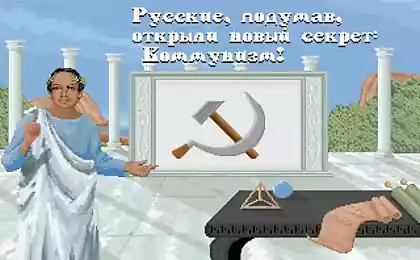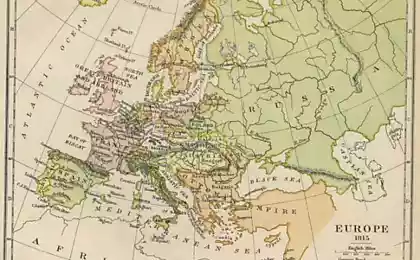2252
Nostalgia and politics. The Soviet Union and Ukraine: where to live better
A recent poll Fund "Democratic initiatives" and the Ukrainian Center for Economic and Political Studies named after Olexander Razumkov Center showed that 41% of Ukrainians believe lives in the Soviet Union until 1985 better than the present. At the same time 39% disagree with this statement, while 20% were undecided.
This issue is very politicized, so it rarely give an objective answer. For example, in the east of the country 56% of Ukrainians believe that life in the USSR was better. The lowest support for the issue among residents of the western regions - 23%.
This article presents facts, how was still the standard of living in the Soviet Union. A detailed analysis shows that the assertion that the Soviet standard of living was higher - a myth. While Ukraine remains one of the poorest countries in Europe, the standard of living is several times higher today than it was in the best periods of the life of the Soviet Union.
The purchasing power of
On 1 January 2013 the average salary in Ukraine amounted to 3377 UAH, the average pension - 1470 UAH. In 1976, the average salary in the USSR was 129 rubles. Specific data on the average pension in the USSR did not help, but the average in the Union, it was 47, 5 rubles.
The average salary in the USSR was lower than in the whole of the USSR, most likely, so it was with a pension. However, to make sure it should be assumed that the average pension in the USSR too, was 47, 5 rubles.
Why did you choose 1976? For the period, which is popularly referred to as the time of the smallest deficit in stores. Although in reality, even in the Brezhnev era "otovaritsya" on the salary the desired product was impossible. The data on prices in the USSR were taken away, and prices on the Ukrainian - from the system of online ordering of goods supermarket "megastore" and other sources. Below - a table that can not afford to Ukrainian average salary in the USSR and Ukraine.
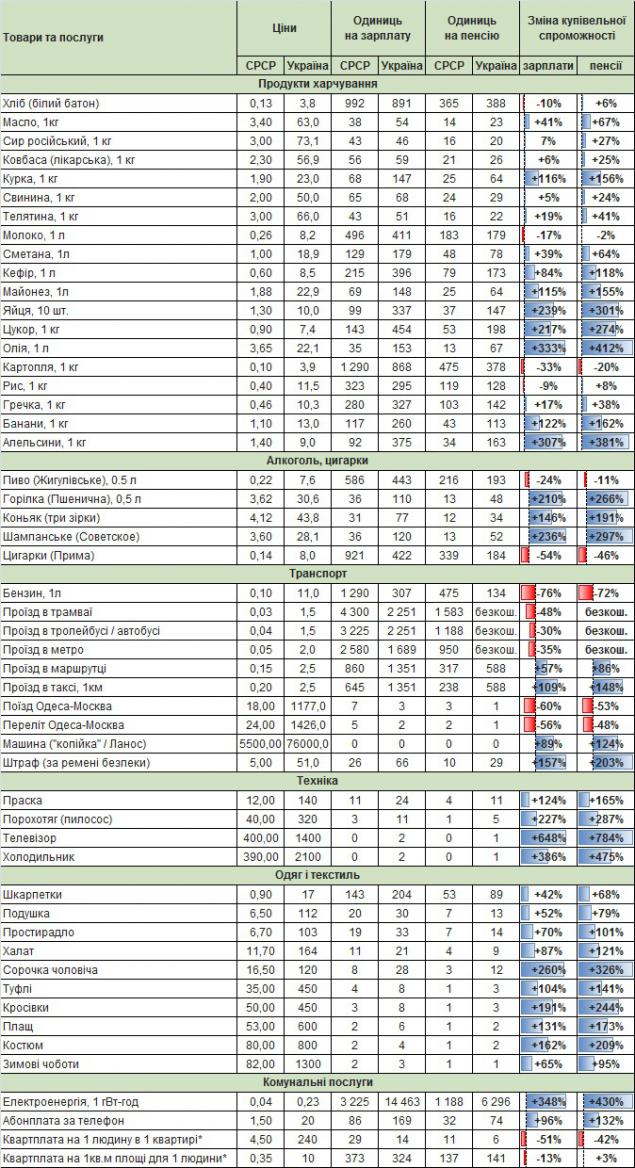
* - Excluding subsidies.
In the USSR, cheap, but more accessible than it is now, there were only some subsidized goods. People who are engaged in the production of sausages in Soviet times, claim: its real cost was 9-10 rubles, although it was sold for 2, 3 rubles. However, subsidies can only be at the expense of the citizens themselves.
Residents of the USSR many times more expensive than at present, treated most kinds of food, clothing and household appliances. In particular, today Ukrainians can not afford four times more eggs and sugar, five times more than oil. Clothing and household appliances, depending on the species, two to eight times more accessible.
Also, now you do not have to stand in line, and range of goods in general is not an example. The quality of products not subject to quantitative evaluation, so this issue will always be open to discussion. We often hear that the quality of certain goods, such as ice cream, bread and sausage, was better in the Soviet Union. The opposite often talk about "blue chickens", cigarettes, clothes, shoes, most of the equipment and cars.
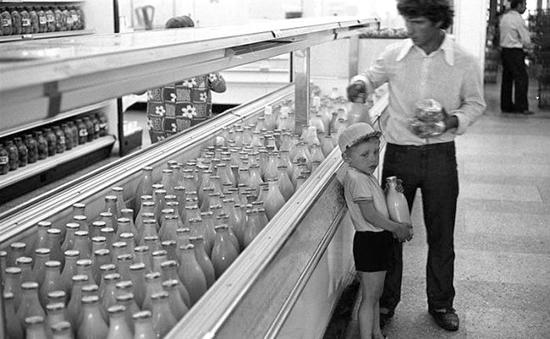
Public services and housing
Detailed analysis shows that the services associated with the maintenance of property, in the Soviet Union were more available than today. The subscription fee for a landline phone and electricity today at two and five times, respectively, more accessible. While other utilities in per capita nominal cost twice as much as in the Soviet Union.
However, today one person accounts for 23 sq m. Of living space, in the Soviet Union in 1975 - only 12 square meters. It is no wonder that utilities, the lion's share of which is heating housing became more expensive per person. Today, however, the state covers utility costs that exceed 10% of the income of 21 square meters. m. area per person, and for the citizens living in a studio apartment - a total area, regardless of the size of the apartment.
10% - roughly the portion of income spent Soviet family for utilities. Thus, we can confidently assert that the availability of public services in Ukraine, no less than it was in the USSR.
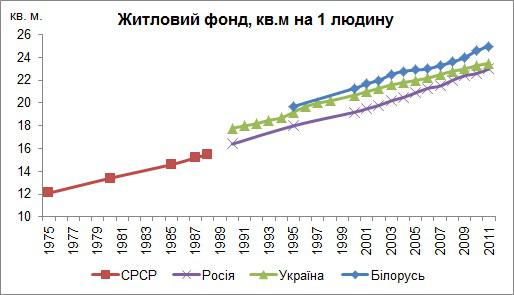
Health
Where higher level of health care - a very difficult question. The problem is that health care can not simply measure the number of beds and the cost of drugs. We need to look at the real figures that characterize the state of health of Ukrainians: life expectancy, mortality, the incidence of diseases.
Health is influenced by many factors: the environment, nutrition, lifestyle, alcohol and cigarettes. The fact that the Ukrainians can afford to eat much better than in the Soviet Union, a positive effect on life expectancy. On the other hand, the amount of alcohol that can buy the Ukrainians, too, grew significantly, though it is unclear whether this led to an increase in its consumption. Actually, smoking and drinking is the number one cause of death among Ukrainians. On the positive side, compared with Soviet times significantly increased range of medicines in pharmacies.
Unfortunately, the authors failed to find comparative data on the cost of medicines during the Soviet era and today. It can be argued only that the life expectancy Ukraine after the recession in 1990 reached the level of Soviet times.
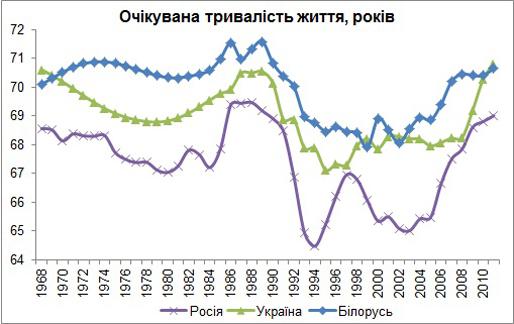
Ukraine has made the most progress in reducing infant mortality. However, during the 1990s, the infant mortality rate in Ukraine has grown in comparison with the Soviet times, in contrast to Russia and Belarus.
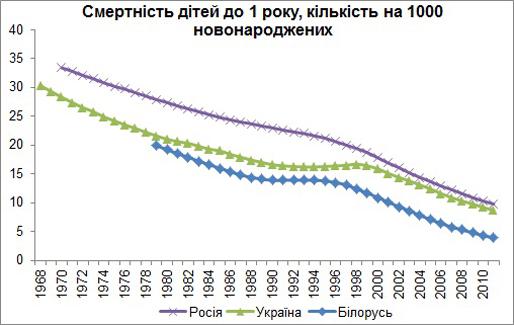
The difference in income between rich and poor
Another common myth about the Soviet Union is the assertion that before the income gap between rich and poor has been less. This statement is true for the 1990s for all former members of the Soviet Union and Russia for today's economy.
However, after the completion of periods of hyperinflation and default rates over the 2000s, there is a significant reduction in the gap in the wealth of a diverse population.
The World Bank estimates that the total income of the richest 10% of Ukrainians are five times higher than the total income of the poorest 10%. According to a study in the USSR B. Sycheva difference was three times more.
However, if the data of the World Bank take into account the shadow economy, the study Sycheva - no. In addition, the study Sycheva ignores the fact that the rich people in the Soviet Union also had better access to scarce goods.
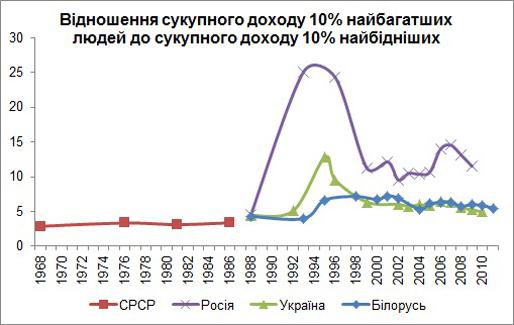
Interestingly, in terms of social policy, Russia, Ukraine and Belarus after the collapse of the Soviet Union have chosen different directions. In Russia - a sudden and significant increase in the income gap between rich and poor in the 1990s than it was in the Ukraine or Belarus.
In Russia still at 2, 5 times more than the difference between the incomes of rich and poor than in Ukraine or Belarus. Today Ukraine is the undisputed champion of social security expenditure among the countries of the socialist camp. In Ukraine, the social assistance is 37% of the income of the population compared with 15% in the Soviet period and 18% in Russia today.
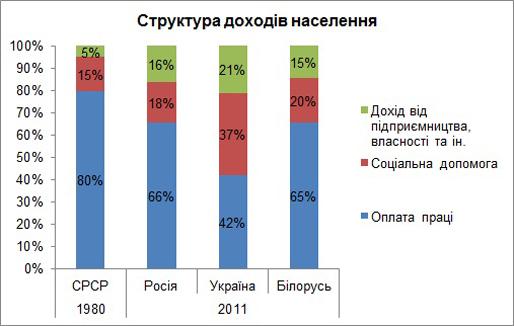
It makes no sense to look back
As shown by the above statistics, the Ukrainians, compared with Soviet times, much higher purchasing power. Interestingly, the purchasing power of pensioners has grown considerably more than the workers.
In the USSR, the average pension amounted to only 33-38% of the average salary. Now the average pension is 44% of the average wage. This is despite the fact that the number of pensioners is equal to the number of officially employed in the economy, and in the Ukrainian workers were twice as much as retirees.
The level difference between the rich and the poor is not much different from what it was in the USSR. Reducing child mortality, life expectancy of not less than in Soviet times. The amount of living space per Ukrainians almost doubled, although not the last role was played by mass emigration and population decline. However, it is only tangible indicators.
To understand the value of such a simple thing as freedom, when it is not, it is necessary only to recall how much cost VCRs and videotapes in the USSR. Over the VCR in the old days gave no less than two thousand. Rub. In the days of the Alliance for a VCR, you could buy a car.
People in secret, risking jail, going to see the terrible quality six times rewritten tape kitsch American militants.
Summing up for the days of the USSR, it is necessary first to present this without the Internet, mobile, foreign films and programs, opportunities to travel abroad or buy imported goods, to choose a place of work or residence. As the history of the Soviet Union, giving freedom in exchange for the promise of cheap products, people, and as a result lose their freedom, and do not receive the promised "freebies". And bring back freedom, giving it once, it is not easy.
Source Your text to link ...
This issue is very politicized, so it rarely give an objective answer. For example, in the east of the country 56% of Ukrainians believe that life in the USSR was better. The lowest support for the issue among residents of the western regions - 23%.
This article presents facts, how was still the standard of living in the Soviet Union. A detailed analysis shows that the assertion that the Soviet standard of living was higher - a myth. While Ukraine remains one of the poorest countries in Europe, the standard of living is several times higher today than it was in the best periods of the life of the Soviet Union.
The purchasing power of
On 1 January 2013 the average salary in Ukraine amounted to 3377 UAH, the average pension - 1470 UAH. In 1976, the average salary in the USSR was 129 rubles. Specific data on the average pension in the USSR did not help, but the average in the Union, it was 47, 5 rubles.
The average salary in the USSR was lower than in the whole of the USSR, most likely, so it was with a pension. However, to make sure it should be assumed that the average pension in the USSR too, was 47, 5 rubles.
Why did you choose 1976? For the period, which is popularly referred to as the time of the smallest deficit in stores. Although in reality, even in the Brezhnev era "otovaritsya" on the salary the desired product was impossible. The data on prices in the USSR were taken away, and prices on the Ukrainian - from the system of online ordering of goods supermarket "megastore" and other sources. Below - a table that can not afford to Ukrainian average salary in the USSR and Ukraine.

* - Excluding subsidies.
In the USSR, cheap, but more accessible than it is now, there were only some subsidized goods. People who are engaged in the production of sausages in Soviet times, claim: its real cost was 9-10 rubles, although it was sold for 2, 3 rubles. However, subsidies can only be at the expense of the citizens themselves.
Residents of the USSR many times more expensive than at present, treated most kinds of food, clothing and household appliances. In particular, today Ukrainians can not afford four times more eggs and sugar, five times more than oil. Clothing and household appliances, depending on the species, two to eight times more accessible.
Also, now you do not have to stand in line, and range of goods in general is not an example. The quality of products not subject to quantitative evaluation, so this issue will always be open to discussion. We often hear that the quality of certain goods, such as ice cream, bread and sausage, was better in the Soviet Union. The opposite often talk about "blue chickens", cigarettes, clothes, shoes, most of the equipment and cars.

Public services and housing
Detailed analysis shows that the services associated with the maintenance of property, in the Soviet Union were more available than today. The subscription fee for a landline phone and electricity today at two and five times, respectively, more accessible. While other utilities in per capita nominal cost twice as much as in the Soviet Union.
However, today one person accounts for 23 sq m. Of living space, in the Soviet Union in 1975 - only 12 square meters. It is no wonder that utilities, the lion's share of which is heating housing became more expensive per person. Today, however, the state covers utility costs that exceed 10% of the income of 21 square meters. m. area per person, and for the citizens living in a studio apartment - a total area, regardless of the size of the apartment.
10% - roughly the portion of income spent Soviet family for utilities. Thus, we can confidently assert that the availability of public services in Ukraine, no less than it was in the USSR.

Health
Where higher level of health care - a very difficult question. The problem is that health care can not simply measure the number of beds and the cost of drugs. We need to look at the real figures that characterize the state of health of Ukrainians: life expectancy, mortality, the incidence of diseases.
Health is influenced by many factors: the environment, nutrition, lifestyle, alcohol and cigarettes. The fact that the Ukrainians can afford to eat much better than in the Soviet Union, a positive effect on life expectancy. On the other hand, the amount of alcohol that can buy the Ukrainians, too, grew significantly, though it is unclear whether this led to an increase in its consumption. Actually, smoking and drinking is the number one cause of death among Ukrainians. On the positive side, compared with Soviet times significantly increased range of medicines in pharmacies.
Unfortunately, the authors failed to find comparative data on the cost of medicines during the Soviet era and today. It can be argued only that the life expectancy Ukraine after the recession in 1990 reached the level of Soviet times.

Ukraine has made the most progress in reducing infant mortality. However, during the 1990s, the infant mortality rate in Ukraine has grown in comparison with the Soviet times, in contrast to Russia and Belarus.

The difference in income between rich and poor
Another common myth about the Soviet Union is the assertion that before the income gap between rich and poor has been less. This statement is true for the 1990s for all former members of the Soviet Union and Russia for today's economy.
However, after the completion of periods of hyperinflation and default rates over the 2000s, there is a significant reduction in the gap in the wealth of a diverse population.
The World Bank estimates that the total income of the richest 10% of Ukrainians are five times higher than the total income of the poorest 10%. According to a study in the USSR B. Sycheva difference was three times more.
However, if the data of the World Bank take into account the shadow economy, the study Sycheva - no. In addition, the study Sycheva ignores the fact that the rich people in the Soviet Union also had better access to scarce goods.

Interestingly, in terms of social policy, Russia, Ukraine and Belarus after the collapse of the Soviet Union have chosen different directions. In Russia - a sudden and significant increase in the income gap between rich and poor in the 1990s than it was in the Ukraine or Belarus.
In Russia still at 2, 5 times more than the difference between the incomes of rich and poor than in Ukraine or Belarus. Today Ukraine is the undisputed champion of social security expenditure among the countries of the socialist camp. In Ukraine, the social assistance is 37% of the income of the population compared with 15% in the Soviet period and 18% in Russia today.

It makes no sense to look back
As shown by the above statistics, the Ukrainians, compared with Soviet times, much higher purchasing power. Interestingly, the purchasing power of pensioners has grown considerably more than the workers.
In the USSR, the average pension amounted to only 33-38% of the average salary. Now the average pension is 44% of the average wage. This is despite the fact that the number of pensioners is equal to the number of officially employed in the economy, and in the Ukrainian workers were twice as much as retirees.
The level difference between the rich and the poor is not much different from what it was in the USSR. Reducing child mortality, life expectancy of not less than in Soviet times. The amount of living space per Ukrainians almost doubled, although not the last role was played by mass emigration and population decline. However, it is only tangible indicators.
To understand the value of such a simple thing as freedom, when it is not, it is necessary only to recall how much cost VCRs and videotapes in the USSR. Over the VCR in the old days gave no less than two thousand. Rub. In the days of the Alliance for a VCR, you could buy a car.
People in secret, risking jail, going to see the terrible quality six times rewritten tape kitsch American militants.
Summing up for the days of the USSR, it is necessary first to present this without the Internet, mobile, foreign films and programs, opportunities to travel abroad or buy imported goods, to choose a place of work or residence. As the history of the Soviet Union, giving freedom in exchange for the promise of cheap products, people, and as a result lose their freedom, and do not receive the promised "freebies". And bring back freedom, giving it once, it is not easy.
Source Your text to link ...

















